小学英语校本教材教案全册
小学英语教育教学教案设计(精选9篇)

小学英语教育教学教案设计(精选9篇)(经典版)编制人:__________________审核人:__________________审批人:__________________编制单位:__________________编制时间:____年____月____日序言下载提示:该文档是本店铺精心编制而成的,希望大家下载后,能够帮助大家解决实际问题。
文档下载后可定制修改,请根据实际需要进行调整和使用,谢谢!并且,本店铺为大家提供各种类型的经典范文,如总结报告、心得体会、应急预案、会议记录、条据书信、合同协议、规章制度、教学资料、作文大全、其他范文等等,想了解不同范文格式和写法,敬请关注!Download tips: This document is carefully compiled by this editor. I hope that after you download it, it can help you solve practical problems. The document can be customized and modified after downloading, please adjust and use it according to actual needs, thank you!Moreover, our store provides various types of classic sample essays, such as summary reports, insights, emergency plans, meeting minutes, evidence letters, contract agreements, rules and regulations, teaching materials, essay summaries, and other sample essays. If you would like to learn about different sample formats and writing methods, please pay attention!小学英语教育教学教案设计(精选9篇)小学英语教育教学教案设计(精选9篇)2024-04-14 12:07:23小学英语教学设计(精选6篇)推荐度:小学英语教学设计范文最新6篇推荐度:热点范文英语(英文:English)是一种西日耳曼语支,最早被中世纪的英国使用,并因其广阔的殖民地而成为世界使用面积最广的语言。
pep小学英语全册教案
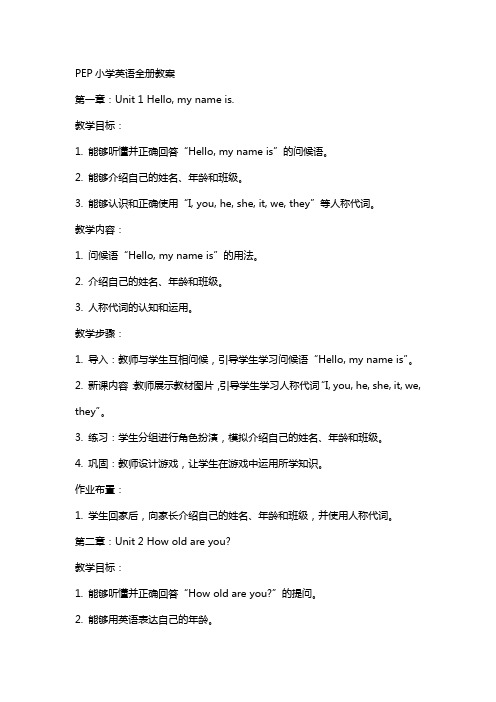
PEP小学英语全册教案第一章:Unit 1 Hello, my name is.教学目标:1. 能够听懂并正确回答“Hello, my name is”的问候语。
2. 能够介绍自己的姓名、年龄和班级。
3. 能够认识和正确使用“I, you, he, she, it, we, they”等人称代词。
教学内容:1. 问候语“Hello, my name is”的用法。
2. 介绍自己的姓名、年龄和班级。
3. 人称代词的认知和运用。
教学步骤:1. 导入:教师与学生互相问候,引导学生学习问候语“Hello, my name is”。
2. 新课内容:教师展示教材图片,引导学生学习人称代词“I, you, he, she, it, we, they”。
3. 练习:学生分组进行角色扮演,模拟介绍自己的姓名、年龄和班级。
4. 巩固:教师设计游戏,让学生在游戏中运用所学知识。
作业布置:1. 学生回家后,向家长介绍自己的姓名、年龄和班级,并使用人称代词。
第二章:Unit 2 How old are you?教学目标:1. 能够听懂并正确回答“How old are you?”的提问。
2. 能够用英语表达自己的年龄。
3. 能够认识和正确使用“I, you, he, she, it, we, they”等人称代词。
教学内容:1. 提问年龄的用法“How old are you?”。
2. 表达自己年龄的方式。
3. 人称代词的认知和运用。
教学步骤:1. 导入:教师与学生互相问候,引导学生学习问候语“How old are you?”。
2. 新课内容:教师展示教材图片,引导学生学习人称代词“I, you, he, she, it, we, they”。
3. 练习:学生分组进行角色扮演,模拟回答“How old are you?”的问题。
4. 巩固:教师设计游戏,让学生在游戏中运用所学知识。
作业布置:1. 学生回家后,向家长提问并回答“How old are you?”的问题。
小学英语教案全英文版
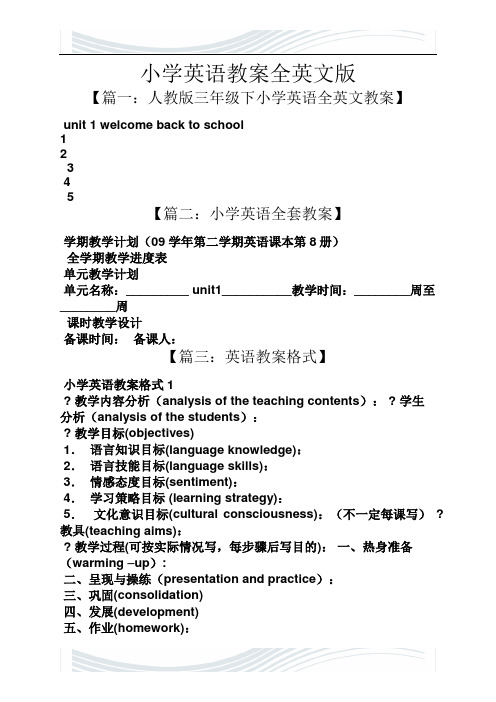
小学英语教案全英文版【篇一:人教版三年级下小学英语全英文教案】unit 1 welcome back to school12345【篇二:小学英语全套教案】学期教学计划(09学年第二学期英语课本第8册)全学期教学进度表单元教学计划单元名称:_________ unit1__________教学时间:________周至________周课时教学设计备课时间:备课人:【篇三:英语教案格式】小学英语教案格式1? 教学内容分析(analysis of the teaching contents): ? 学生分析(analysis of the students):? 教学目标(objectives)1.语言知识目标(language knowledge):2.语言技能目标(language skills):3.情感态度目标(sentiment):4.学习策略目标 (learning strategy):5.文化意识目标(cultural consciousness):(不一定每课写)? 教具(teaching aims):? 教学过程(可按实际情况写,每步骤后写目的):一、热身准备(warming –up):二、呈现与操练(presentation and practice):三、巩固(consolidation)四、发展(development)五、作业(homework):? 板书设计:? 附上练习:范例一:unit3 let’s talk 第一课时小学三年级教学重点:how are you? fine, thank you. 等问候语的学习。
教学难点: 1、how are you? 的得体运用。
2、fine, thank you.中 fine 一词字母 i 的发音不容易到位。
教具准备:1、本课let’s talk/a 部分的教学课件。
2、教师为学生准备3—4个扩音器。
3、本课时教学配套的录音带,以及歌曲“hello”“head, shoulders, knees and toes”的录音带。
全英版小学英语教案【三篇】

【导语】⾼尚的理想是⼈⽣的指路明灯。
有了它,⽣活就有了⽅向;有了它,内⼼就感到充实。
迈开坚定的步伐,⾛向既定的⽬标吧!以下是为⼤家整理的《全英版⼩学英语教案【三篇】》供您查阅。
⼩学英语教案全英版⼀: Part A Let’s say, Let’s chant Part C Culture Teaching Aims : 1. Be able to listen, say, recognize the words: apple, ant, boy, bag, Coke, coffee. 2. Be able to listen, say, read and write these three letters: A a; B b; C c 3. Through the chant review the letters of ABC, train a sense of group identity. Focus Points & Difficult Points : Read the letters: Big letter C, small letter c; Write down them correctly and handsomely. Teaching Preparation: 1. Letter cards ,some word pictures, word cards: apple boy eraser ant crayon body head cake Coke coffee bag ball 2. A little blackboard with four-line format and a ball. Designing for the blackboard: panda beaver eagle kangaroo (pictures) China Canada America Australia (words) Teaching Steps: Step1. Warm –up 1. Sing a song. 2. Free talk T: Hello. I’m Wendy. I’m from Hangzhou. S1: Hello! I’m ... I’m from Hangzhou,too. T: Nice to meet you. S: Nice to meet you, too. T: Let’s play. Ok? S: Great! T: Watch out! (T throws the ball.) S: Oh, no. Make a similar dialogue with your partner. Step2.Presentation. 1. 1)T : Today, we will learn letters. Do you know letters? Just as A,B,C…… They are letters. What’s the meaning of letters? S: 字母。
英语校本课程教案

英语校本课程教案第一章:课程概述1.1 课程背景本课程旨在提高学生的英语综合运用能力,结合学校实际情况,为学生提供更多元化的学习机会,拓宽视野,培养他们对英语的兴趣和热情。
1.2 课程目标通过本课程的学习,学生能提高英语听说读写的能力,增强英语实际应用能力,了解不同文化背景,提升跨文化交际意识。
1.3 课程内容第二章:教学方法2.1 任务型教学法通过完成各种真实的任务,激发学生的学习兴趣,培养学生的合作精神,提高学生的综合语言运用能力。
2.2 情境教学法创设真实的语言环境,让学生在各种情境中自然地学习和使用英语。
2.3 交际教学法注重学生之间的互动交流,提高学生的口头表达能力和交际能力。
第三章:教学评估3.1 形成性评估通过观察、记录、分析学生在课堂上的表现,及时了解学生的学习情况,调整教学策略。
3.2 终结性评估第四章:教学资源4.1 教材选用适合学生的英语教材,如《新概念英语》、《英语口语教程》等。
4.2 辅助材料利用多媒体课件、网络资源、报纸杂志、英语电影等丰富教学内容。
4.3 教学设备使用投影仪、计算机、录音机、音响等设备,提高教学质量。
第五章:教学计划5.1 第一学期教学计划第一周至第四周:英语语音教学第五周至第八周:词汇和语法教学第九周至第十四周:听力口语教学第十五周至第十八周:阅读写作教学第十九周至第二十周:英美文化介绍5.2 第二学期教学计划第一周至第四周:英语语音复习第五周至第八周:词汇和语法复习第九周至第十四周:听力口语复习第十五周至第十八周:阅读写作复习第十九周至第二十周:跨文化交际实践第六章:课堂管理6.1 纪律管理6.2 情感管理关注学生的情感需求,鼓励学生积极参与,增强他们的自信心。
6.3 学生分组根据学生的英语水平、性格特点等因素,合理分组,促进小组合作学习。
第七章:课堂活动设计7.1 热身活动通过歌曲、游戏、话题讨论等方式,激发学生的学习兴趣。
7.2 主体活动设计各种教学活动,如角色扮演、小组竞赛、案例分析等,让学生在实践中学习英语。
小学英语校本课程教案

小学英语校本课程教案一、课程背景本课程旨在通过校本课程的形式,为小学生提供一个学习英语的平台,帮助他们掌握基本的英语语法、词汇和口语表达能力。
通过本课程的学习,学生将能够更好地适应小学阶段的英语学习需求,提高他们的英语综合素质。
二、教学目标1. 让学生掌握基本的英语字母、发音规则和单词。
2. 培养学生基本的英语听、说、读、写能力。
3. 帮助学生建立英语学习的兴趣和自信心。
三、教学内容1. 英语字母表的学习。
2. 基本词汇的学习与运用。
3. 简单句型的练习。
4. 日常英语口语的交流。
5. 英语绘本的阅读与欣赏。
四、教学方法1. 采用互动式教学法,激发学生的学习兴趣和积极性。
2. 利用多媒体教学资源,为学生提供丰富的学习材料。
3. 创设情境,让学生在实际环境中运用英语。
4. 组织小组活动,培养学生的合作精神和团队意识。
5. 注重个体差异,因材施教。
五、教学评价1. 定期进行课堂测试,检查学生对知识的掌握程度。
2. 观察学生的日常作业,了解他们的学习进度。
3. 鼓励学生参加英语角、英语剧社等校内外活动,提高他们的实际应用能力。
4. 定期与家长沟通,了解学生的学习状况,并给予针对性的指导。
5. 注重学生的综合素质评价,鼓励他们在英语学习中获得进步。
六、教学资源1. 教材:人教版《小学英语》教材。
2. 辅助材料:英语绘本、图片、卡片、多媒体教学软件等。
3. 教学设施:投影仪、计算机、音响设备、白板等。
4. 网络资源:英语学习网站、在线教学平台等。
5. 实物教具:玩具、日用品等。
七、教学进度安排1. 每周安排两节英语课,共计40分钟。
2. 每个教学单元包含4个课时,每个课时约10-15分钟。
3. 教学进度根据学生的实际学习情况进行调整。
4. 每学期进行一次期中考试,期末进行一次期末考试。
八、教学活动设计1. 字母教学活动:通过歌曲、游戏等形式,让学生掌握英语字母的发音和书写。
2. 词汇教学活动:利用图片、卡片等辅助材料,让学生学习并运用基本词汇。
小学英语校本课程教案

小学英语校本课程教案第一章:问候与自我介绍教学目标:1. 学生能够用英语进行简单的问候和自我介绍。
2. 学生能够理解和使用基本的英语口语表达方式。
教学内容:1. 学习英语问候语,如“Hello”,“Good morning”,“Good afternoon”,“Good evening”等。
2. 学习自我介绍的表达方式,如“My name is”,“I am from”,“I am in grade”等。
教学活动:1. 教师与学生进行简单的英语问候和自我介绍,为学生树立榜样。
2. 学生进行小组活动,相互问候并进行自我介绍。
3. 学生进行角色扮演,模拟在不同的场合下使用英语问候和自我介绍。
第二章:数字与计数教学目标:1. 学生能够用英语正确地表达数字0-100。
2. 学生能够进行基本的数学计算,如加减法。
教学内容:1. 学习数字0-100的英语表达方式,如“zero”,“one”,“two”,“three”等。
2. 学习基本的数学计算词汇,如“add”,“subtract”,“multiply”,“divide”等。
教学活动:1. 教师引导学生学习数字0-100的英语表达方式,并进行口头练习。
2. 学生进行小组活动,使用英语进行简单的数学计算练习。
3. 学生进行游戏,如数字接龙,加深对数字和计数的理解和记忆。
第三章:颜色与形状教学目标:1. 学生能够用英语正确地表达常见颜色和形状。
2. 学生能够用英语描述物体的颜色和形状。
教学内容:1. 学习常见颜色的英语表达方式,如“red”,“blue”,“green”,“yellow”等。
2. 学习常见形状的英语表达方式,如“circle”,“square”,“triangle”,“rectangle”等。
教学活动:1. 教师引导学生学习常见颜色和形状的英语表达方式,并进行口头练习。
2. 学生进行小组活动,用英语描述教师出示的颜色和形状。
3. 学生进行绘画活动,用英语标出所画物体的颜色和形状。
小学四年级(下册)英语全册教案

小学四年级(下册)英语全册教案第一课:Unit 1 - Where is My Bag?目标:- 学会询问物品的位置- 学会描述物品的位置教学内容:1. 词汇:- bag(书包)- desk(书桌)- chair(椅子)- bed(床)- table(桌子)2. 句型:- Where is my bag?(我的书包在哪里?)- It's on/under/next to/in the/desk.(它在/在...下面/在旁边/在...里面/在书桌上。
)教学步骤:1. 导入新知识:- 呈现图片,介绍新词汇(bag、desk、chair、bed、table)并教授发音。
- 引导学生猜测并回答“Where is my bag?”2. 教授句型:- 教授句型“Where is my bag?”,并简单解释句子的意思。
- 引导学生模仿老师的问句并回答。
3. 练:- 学生互相提问“Where is my bag?”,并回答。
4. 游戏活动:- 以课堂上的物品为参考,老师指定某个物品,学生根据所学句型回答物品的位置。
5. 小结:- 学生总结所学内容。
6. 课后作业:- 学生回家后观察家庭中的物品,并用所学句型描述物品的位置。
第二课:Unit 2 - What is in the Bag?目标:- 研究询问物品的内容- 研究回答物品的内容教学内容:1. 词汇:- pencil(铅笔)- book(书)- eraser(橡皮)- ruler(尺子)- pen(钢笔)2. 句型:- What's in the bag?(书包里有什么?)- There are/There is...(里面有...)教学步骤:1. 导入新知识:- 呈现图片,介绍新词汇(pencil、book、eraser、ruler、pen)并教授发音。
- 引导学生回答“What's in the bag?”2. 教授句型:- 教授句型“What's in the bag?”,并简单解释句子的意思。
小学英语全英语教案5篇
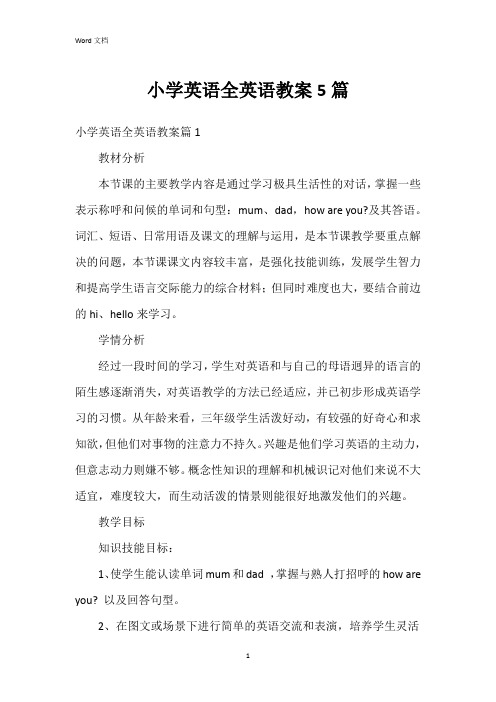
小学英语全英语教案5篇小学英语全英语教案篇1教材分析本节课的主要教学内容是通过学习极具生活性的对话,掌握一些表示称呼和问候的单词和句型:mum、dad,how are you?及其答语。
词汇、短语、日常用语及课文的理解与运用,是本节课教学要重点解决的问题,本节课课文内容较丰富,是强化技能训练,发展学生智力和提高学生语言交际能力的综合材料;但同时难度也大,要结合前边的hi、hello来学习。
学情分析经过一段时间的学习,学生对英语和与自己的母语迥异的语言的陌生感逐渐消失,对英语教学的方法已经适应,并已初步形成英语学习的习惯。
从年龄来看,三年级学生活泼好动,有较强的好奇心和求知欲,但他们对事物的注意力不持久。
兴趣是他们学习英语的主动力,但意志动力则嫌不够。
概念性知识的理解和机械识记对他们来说不大适宜,难度较大,而生动活泼的情景则能很好地激发他们的兴趣。
教学目标知识技能目标:1、使学生能认读单词mum和dad ,掌握与熟人打招呼的how are you? 以及回答句型。
2、在图文或场景下进行简单的英语交流和表演,培养学生灵活运用所学知识进行交流的能力。
过程与方法目标:1、通过本课学习使学生有兴趣听、说英语,唱英语歌,做游戏,敢于开口,乐于模仿。
2、在鼓励性评价中树立自信心,在小组活动中积极参与合作,从而意识到交流对学习英语的重要性。
情感态度价值观目标:1、能够恰当使用英语中与人问好的问候语,了解在英语国家中熟人见面相互打招呼的方式。
2、对学生进行日常行为礼貌教育。
教学重点和难点1、见面问好的句型:how are you? 和各种回答方法。
how are you? 与how do you do? nice to meet you. 等问候语的用法区别。
2、培养学生合作学习的能力,同时注意培养学生学习英语的兴趣,树立自信心。
小学英语全英语教案篇2一、教学目标与要求1、能够听、说、读、写以下动词短语:eat breakfast , do morning exercises , have english class , play sports , eat dinner .2、能够听懂问句:when do you do morning exercises/……并能用所学动词短语替换句型“i usually …at…”中的关键词回答问句。
英语教案模板小学全英
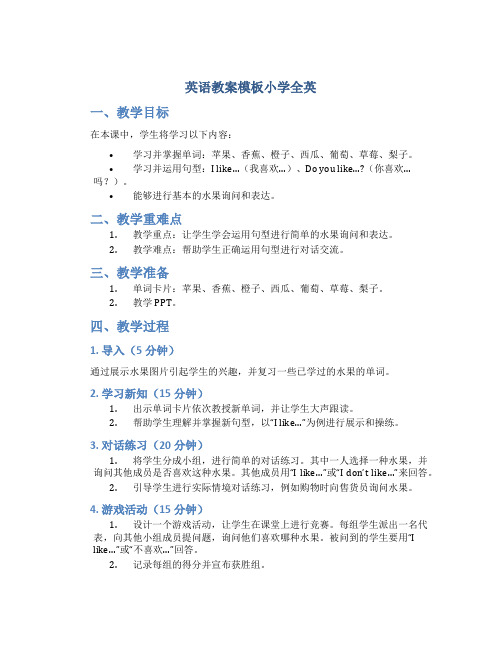
英语教案模板小学全英一、教学目标在本课中,学生将学习以下内容:•学习并掌握单词:苹果、香蕉、橙子、西瓜、葡萄、草莓、梨子。
•学习并运用句型:I like…(我喜欢…)、Do you like…?(你喜欢…吗?)。
•能够进行基本的水果询问和表达。
二、教学重难点1.教学重点:让学生学会运用句型进行简单的水果询问和表达。
2.教学难点:帮助学生正确运用句型进行对话交流。
三、教学准备1.单词卡片:苹果、香蕉、橙子、西瓜、葡萄、草莓、梨子。
2.教学PPT。
四、教学过程1. 导入(5分钟)通过展示水果图片引起学生的兴趣,并复习一些已学过的水果的单词。
2. 学习新知(15分钟)1.出示单词卡片依次教授新单词,并让学生大声跟读。
2.帮助学生理解并掌握新句型,以“I like…”为例进行展示和操练。
3. 对话练习(20分钟)1.将学生分成小组,进行简单的对话练习。
其中一人选择一种水果,并询问其他成员是否喜欢这种水果。
其他成员用“I like…”或“I don’t like…”来回答。
2.引导学生进行实际情境对话练习,例如购物时向售货员询问水果。
4. 游戏活动(15分钟)1.设计一个游戏活动,让学生在课堂上进行竞赛。
每组学生派出一名代表,向其他小组成员提问题,询问他们喜欢哪种水果。
被问到的学生要用“I like…”或“不喜欢…”回答。
2.记录每组的得分并宣布获胜组。
5. 总结和小结(5分钟)回顾本节课所学内容,总结学生们在对话和游戏中的表现,并强调学生正确应用所学知识的重要性。
五、课堂作业1.小组合作:编写一段对话,运用本节课所学的句型和单词,进行水果询问和表达。
2.完成课堂练习题。
六、教学反思本节课通过多种教学方法,如图片引导、游戏活动等,增加了学生的参与度和兴趣。
学生们积极参与讨论和练习,对所学内容有了初步的掌握。
在今后的教学中,可以进一步提高学生的表达能力,增加更多的实际情境对话练习,激发学生的学习兴趣和主动性。
小学英语校本课程教案
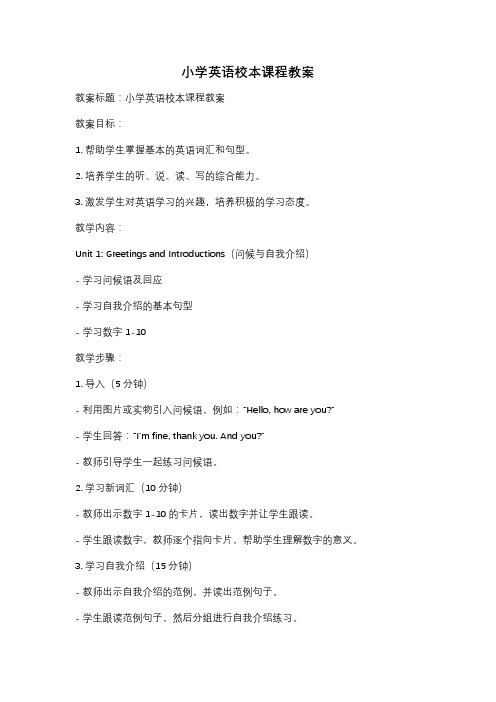
小学英语校本课程教案教案标题:小学英语校本课程教案教案目标:1. 帮助学生掌握基本的英语词汇和句型。
2. 培养学生的听、说、读、写的综合能力。
3. 激发学生对英语学习的兴趣,培养积极的学习态度。
教学内容:Unit 1: Greetings and Introductions(问候与自我介绍)- 学习问候语及回应- 学习自我介绍的基本句型- 学习数字1-10教学步骤:1. 导入(5分钟)- 利用图片或实物引入问候语,例如:“Hello, how are you?”- 学生回答:“I'm fine, thank you. And you?”- 教师引导学生一起练习问候语。
2. 学习新词汇(10分钟)- 教师出示数字1-10的卡片,读出数字并让学生跟读。
- 学生跟读数字,教师逐个指向卡片,帮助学生理解数字的意义。
3. 学习自我介绍(15分钟)- 教师出示自我介绍的范例,并读出范例句子。
- 学生跟读范例句子,然后分组进行自我介绍练习。
- 教师鼓励学生互相交流,用英语进行自我介绍。
4. 练习与巩固(15分钟)- 教师设计问答练习,让学生用英语进行问候和回应。
- 学生分角色进行练习,可以模拟真实场景,如在校门口相遇等。
5. 小结与作业布置(5分钟)- 教师总结本节课所学内容,并强调学生的表现和进步。
- 布置作业:要求学生用英语写一篇简短的自我介绍。
教学资源:- 数字卡片- 自我介绍范例- 图片或实物引导问候语评估方式:- 教师观察学生在练习中的表现,包括发音准确性、句子的流利程度等。
- 学生的书面作业,包括自我介绍的书写和语法正确性。
教案扩展:- 可以引入更多的问候语和自我介绍的句型,让学生有更多的表达方式。
- 可以设计游戏或活动,让学生在实际情境中运用所学知识,增加趣味性和实用性。
注意事项:- 确保课堂氛围积极活跃,鼓励学生大胆尝试用英语表达。
- 针对不同学生的程度和兴趣,灵活调整教学内容和难度。
小学英语校本教材教案全册

小学英语校本教材教案全册第一章:字母学习一、教学目标1. 学生能够正确识别并书写26个英文字母。
2. 学生能够理解字母在单词中的发音。
3. 学生能够运用字母进行简单的单词拼写。
二、教学内容1. 字母表的顺序和名称。
2. 字母在单词中的发音规则。
3. 字母的书写规范。
三、教学步骤1. 教师出示字母表,引导学生跟读并记忆字母名称。
2. 教师讲解字母在单词中的发音规则,并通过示例单词进行讲解。
3. 教师示范字母的书写,学生跟随书写。
4. 学生进行字母书写练习,教师给予反馈。
四、作业布置1. 学生回家后复习字母表,记忆字母名称。
2. 学生练习书写字母,注意书写规范。
五、教学评价1. 教师通过字母表测试检查学生对字母名称的掌握情况。
2. 教师通过听写单词检查学生对字母发音的掌握情况。
3. 教师通过观察学生的书写作业,评价学生的书写规范性。
第二章:基本句型一、教学目标1. 学生能够理解并运用基本句型进行表达。
2. 学生能够正确使用常用的疑问词。
3. 学生能够进行简单的问答交流。
二、教学内容1. 基本句型的结构及其用法。
2. 常用的疑问词及其用法。
3. 简单的问答交流。
三、教学步骤1. 教师出示基本句型,引导学生理解并跟读。
2. 教师讲解疑问词的用法,并通过示例进行讲解。
3. 教师组织学生进行问答练习,引导学生进行交流。
四、作业布置1. 学生回家后复习基本句型,并尝试进行问答练习。
2. 学生练习使用疑问词进行提问,并回答。
五、教学评价1. 教师通过问答测试检查学生对基本句型的掌握情况。
2. 教师通过观察学生的问答练习,评价学生的交流能力。
第三章:颜色和数字一、教学目标1. 学生能够正确识别并说出常用的颜色和数字。
2. 学生能够用英语描述物体的颜色和数量。
3. 学生能够运用颜色和数字进行简单的句子表达。
二、教学内容1. 常用的颜色和数字的英文表达。
2. 描述物体颜色和数量的句型。
3. 运用颜色和数字进行句子表达。
小学英语教案全英文版【三篇】
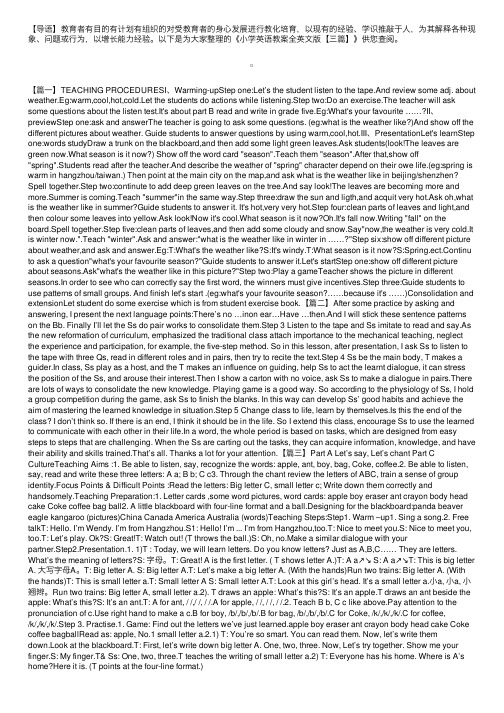
【导语】教育者有⽬的有计划有组织的对受教育者的⾝⼼发展进⾏教化培育,以现有的经验、学识推敲于⼈,为其解释各种现象、问题或⾏为,以增长能⼒经验。
以下是为⼤家整理的《⼩学英语教案全英⽂版【三篇】》供您查阅。
【篇⼀】TEACHING PROCEDURESI、Warming-upStep one:Let’s the student listen to the tape.And review some adj. about weather.Eg:warm,cool,hot,cold.Let the students do actions while listening.Step two:Do an exercise.The teacher will ask some questions about the listen test.It's about part B read and write in grade five.Eg:What's your favourite (II)previewStep one:ask and answerThe teacher is going to ask some questions. (eg:what is the weather like?)And show off the different pictures about weather. Guide students to answer questions by using warm,cool,hot.III、PresentationLet's learnStep one:words studyDraw a trunk on the blackboard,and then add some light green leaves.Ask students(look!The leaves are green now.What season is it now?) Show off the word card "season".Teach them "season".After that,show off "spring".Students read after the teacher.And describe the weather of "spring" character depend on their owe life.(eg:spring is warm in hangzhou/taiwan.) Then point at the main city on the map,and ask what is the weather like in beijing/shenzhen? Spell together.Step two:continute to add deep green leaves on the tree.And say look!The leaves are becoming more and more.Summer is coming.Teach "summer"in the same way.Step three:draw the sun and ligth,and acquit very hot.Ask oh,what is the weather like in summer?Guide students to answer it. It's hot,very very hot.Step four:clean parts of leaves and light,and then colour some leaves into yellow.Ask look!Now it's cool.What season is it now?Oh.It's fall now.Writing "fall" on the board.Spell together.Step five:clean parts of leaves,and then add some cloudy and snow.Say"now,the weather is very cold.It is winter now.".Teach "winter".Ask and answer:"what is the weather like in winter in ……?"Step six:show off different picture about weather,and ask and answer.Eg:T:What's the weather like?S:It's windy.T:What season is it now?S:Spring.ect.Continu to ask a question"what's your favourite season?"Guide students to answer it.Let's startStep one:show off different picture about seasons.Ask"what's the weather like in this picture?"Step two:Play a gameTeacher shows the picture in different seasons.In order to see who can correctly say the first word, the winners must give incentives.Step three:Guide students to use patterns of small groups. And finish let's start .(eg:what's your favourite season?……because it's ……)Consolidation and extensionLet student do some exercise which is from student exercise book.【篇⼆】After some practice by asking and answering, I present the next language points:There’s no …inon ear…Have …then.And I will stick these sentence patterns on the Bb. Finally I’ll let the Ss do pair works to consolidate them.Step 3 Listen to the tape and Ss imitate to read and say.As the new reformation of curriculum, emphasized the traditional class attach importance to the mechanical teaching, neglect the experience and participation, for example, the five-step method. So in this lesson, after presentation, I ask Ss to listen to the tape with three Qs, read in different roles and in pairs, then try to recite the text.Step 4 Ss be the main body, T makes a guider.In class, Ss play as a host, and the T makes an influence on guiding, help Ss to act the learnt dialogue, it can stress the position of the Ss, and arouse their interest.Then I show a carton with no voice, ask Ss to make a dialogue in pairs.There are lots of ways to consolidate the new knowledge. Playing game is a good way. So according to the physiology of Ss, I hold a group competition during the game, ask Ss to finish the blanks. In this way can develop Ss’ good habits and achieve the aim of mastering the learned knowledge in situation.Step 5 Change class to life, learn by themselves.Is this the end of the class? I don’t think so. If there is an end, I think it should be in the life. So I extend this class, encourage Ss to use the learned to communicate with each other in their life.In a word, the whole period is based on tasks, which are designed from easy steps to steps that are challenging. When the Ss are carting out the tasks, they can acquire information, knowledge, and have their ability and skills trained.That’s all. Thanks a lot for your attention.【篇三】Part A Let’s say, Let’s chant Part C CultureTeaching Aims :1. Be able to listen, say, recognize the words: apple, ant, boy, bag, Coke, coffee.2. Be able to listen, say, read and write these three letters: A a; B b; C c3. Through the chant review the letters of ABC, train a sense of group identity.Focus Points & Difficult Points :Read the letters: Big letter C, small letter c; Write down them correctly and handsomely.Teaching Preparation:1. Letter cards ,some word pictures, word cards: apple boy eraser ant crayon body head cake Coke coffee bag ball2. A little blackboard with four-line format and a ball.Designing for the blackboard:panda beaver eagle kangaroo (pictures)China Canada America Australia (words)Teaching Steps:Step1. Warm –up1. Sing a song.2. Free talkT: Hello. I’m Wendy. I’m from Hangzhou.S1: Hello! I’m ... I’m from Hangzhou,too.T: Nice to meet you.S: Nice to meet you, too.T: Let’s play. Ok?S: Great!T: Watch out! (T throws the ball.)S: Oh, no.Make a similar dialogue with yourpartner.Step2.Presentation.1. 1)T : Today, we will learn letters. Do you know letters? Just as A,B,C…… They are letters. What’s the meaning of letters?S: 字母。
小学英语教案全英文版(优秀13篇)
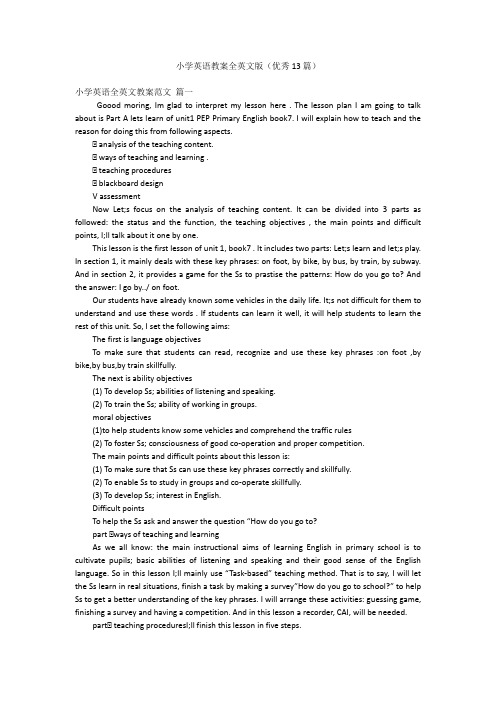
小学英语教案全英文版(优秀13篇)小学英语全英文教案范文篇一Goood moring, Im glad to interpret my lesson here . The lesson plan I am going to talk about is Part A lets learn of unit1 PEP Primary English book7. I will explain how to teach and the reason for doing this from following aspects.Ⅰ analysis of the teaching content.Ⅰ ways of teaching and learning .Ⅰ teaching proceduresⅠ blackboard designV assessmentNow Let;s focus on the analysis of teaching content. It can be divided into 3 parts as followed: the status and the function, the teaching objectives , the main points and difficult points, I;ll talk about it one by one.This lesson is the first lesson of unit 1, book7 . It includes two parts: Let;s learn and let;s play. In section 1, it mainly deals with these key phrases: on foot, by bike, by bus, by train, by subway. And in section 2, it provides a game for the Ss to prastise the patterns: How do you go to? And the answer: I go by../ on foot.Our students have already known some vehicles in the daily life. It;s not difficult for them to understand and use these words . If students can learn it well, it will help students to learn the rest of this unit. So, I set the following aims:The first is language objectivesTo make sure that students can read, recognize and use these key phrases :on foot ,by bike,by bus,by train skillfully.The next is ability objectives(1) To develop Ss; abilities of listening and speaking.(2) To train the Ss; ability of working in groups.moral objectives(1)to help students know some vehicles and comprehend the traffic rules(2) To foster Ss; consciousness of good co-operation and proper competition.The main points and difficult points about this lesson is:(1) To make sure that Ss can use these key phrases correctly and skillfully.(2) To enable Ss to study in groups and co-operate skillfully.(3) To develop Ss; interest in English.Difficult pointsTo help the Ss ask and answer the question “How do you go to?part Ⅰways of teaching and learningAs we all know: the main instructional aims of learning English in primary school is to cultivate pupils; basic abilities of listening and speaking and their good sense of the English language. So in this lesson I;ll mainly use “Task-based” teaching method. That is to say, I will let the Ss learn in real situations, finish a task by making a survey”How do you go to school?” to help Ss to get a better understanding of the key phrases. I will arrange these activities: guessing game, finishing a survey and having a competition. And in this lesson a recorder, CAI, will be needed.partⅠ teaching proceduresI;ll finish this lesson in five steps.step1 lead--in activitiesI will begin my class with drawing and guessing game, just like this : I show students some vehicles such as bike ,bus ,jeep which they learned before by Stick Figures and ask them guess what;s it.Purpose: It is important to form a better English learning surrounding for the Ss by guessing game. and at the same time it provides situations to review learned knowledge for the next step.step2 prestentationNow I;ll mainly talk about this step.1、first there is a Free talk between T and Ss. For example: I show many pictures of beautiful cities and ask students some questions, such as do you like this city?where do you want to go ?and help Ss to answer them with by train ,by plane,by ship.By the way, I show the picture of a school, and say“ I go to schiool by bus” ,Ss read this sentence. do the actions and ask how do you go to school?,show many pictures of tools such as ,on foot by bike ,by bus to help students answer my question one by one.To present the key structures one by one is much easier for the Ss to learn and grasp the meanings.2 With the help of the CAI I set a situation to help Ss understand the way of using these key phrases:A boy is coming, who is going to school. He says: I go to school byThen play the sounds of bus, bike ask students to listen carefully and tell “I go to school by according to the different sounds, by the way , I present another new phrases:by subwayPurpose:Make Ss use these new phrases with sentence structures, to help Ss use the language in a real situation.step3 practise3 I order to make every student read these new phrases correctly, I design a drill in this step,I show cards as soon as possible ,students should read the words quickly and spell them. Then I ask How do you go to school?students answer I go to ......also I will quicken the speed to ask .The purpose is to draw the whole studentsattention to the spelling of the words4 After this, I ask Ss to do Lets play in fours. They use places cards and vehicle cards, ask and answer:How do you go to ? I go to by”5, If Ss can ask and answer expertly, I will ask them to make a short dialogue.the purpose of this is to help students to learn those sentenses through a ture situation and make the dialogues in order to check if Ss can usse these key prases、sentences structures skillfullystep 4 consolidationlet students do a survey about how do you go to school?and the table like this :write down names and tools another Ss chooseTask-based teaching method is used here to develop Ss; ability of ; communication and also their ability of co-operation will be well trained.step 5 homeworkask students to collect other kinds of transport tools through the library ,computer.the purpose of this is to stimulate the interest of learning english and to wide the studentsknowledgestep6 blackboard designmy blackboard design like this :on the left Ishow the phrases:on foot,by bus.......on the right there are many sentences:how do you go to school?I go to ......step 7 assessmentdue to the studentsage ,I make every students work in class through many activities in order to stimulate the studentsinterest and provide they a wide thinking room. I make students learn this lesson very well through desiring scene statuesthats all,thank you for your listening !Unit 1 Lesson 篇二Part A Let;s say, Let;s chant Part C CultureTeaching Aims :1、Be able to listen, say, recognize the words: apple, ant, boy, bag, Coke, coffee.2、Be able to listen, say, read and write these three letters: A a; B b; C c3、Through the chant review the letters of ABC, train a sense of group identity.Focus Points amp; Difficult Points :Read the letters: Big letter C, small letter c; Write down them correctly and handsomely.Teaching Preparation:1、Letter cards ,some word pictures, word cards: apple boy eraser ant crayon body head cake Coke coffee bag ball2、A little blackboard with four-line format and a ball.Designing for the blackboard:panda beaver eagle kangaroo (pictures)China Canada America Australia (words)Teaching Steps:Step1. Warm ndash;up1、Sing a song.2、Free talkT: Hello. I;m Wendy. I;m from Hangzhou.S1: Hello! I;m 。
英语教案模板小学全英

英语教案模板小学全英一、教学目标通过本次课程的学习,学生将能够: - 理解并正确发音英语的基础单词; - 掌握英语的基本问候语和自我介绍; - 学会用简单的句子进行日常对话; - 培养英语学习的兴趣和自信心。
二、教学准备•教材:小学英语教材《英语乐园》第一册Unit 1;•多媒体设备;•小黑板/白板及相应的书写工具;•卡片或图片,包括日常生活中常见的物品和动作。
三、教学过程1. 导入(5分钟)教师用多媒体设备播放一段有趣的英语动画片,引起学生的兴趣和好奇心,为今日的学习打下基础。
2. 新课呈现(10分钟)教师向学生展示一些日常生活中常见的物品和动作的图片或卡片,引导学生使用英语表达并猜测物品或动作的名称。
3. 情景对话(15分钟)教师通过多媒体设备展示两个学生在日常生活中进行简单对话的情景,例如问候和自我介绍。
然后,教师可以先模仿一个角色与学生进行问候和自我介绍的对话,并鼓励学生模仿并进行互动。
4. 单词学习(15分钟)教师通过观看图片或卡片,引导学生阅读并学习与日常生活相关的基础单词。
教师可以写出单词的拼写和音标,并进行正确的发音示范。
5. 听力练习(15分钟)教师利用多媒体设备播放一段简短的日常对话,然后提出几个相关问题。
学生们通过听对话回答问题,提高他们的听力能力。
6. 合作活动(15分钟)教师将学生分成小组,每组选出一名代表。
然后,教师给每个代表发放一幅图片或卡片,并告诉学生通过描述图片或卡片上的内容让其他组的学生猜测。
学生们通过合作和交流提高他们的口语表达能力。
7. 小结(5分钟)教师带领学生回顾今天所学的重点内容,并强调学生应该继续练习并加深记忆。
鼓励学生在日常生活中使用英语进行简单的沟通。
四、教学延伸鼓励学生在家里与家人进行英语的简单对话,例如询问家人的情况,自我介绍等。
并鼓励他们通过观看英语动画片、听英语歌曲等方式提高英语听力和口语表达能力。
五、教学评价•教师观察并评估学生在课堂上的参与和答题情况;•教师通过与学生的互动和口头测试来评估学生的口语表达能力;•教师检查和评估学生在听力练习中的表现。
小学英语全英文教案全英版

小学英语全英文教案全英版Unit 1 Lesson 3Part A Lets say, Lets chant Part C CultureTeaching Aims :1. Be able to listen, say, recognize the words: apple, ant, boy, bag, Coke, coffee.2. Be able to listen, say, read and write these three letters:A a;B b;C c3. Through the chant review the letters of ABC, train a sense of group identity.Focus PointsDifficult Points :Read the letters: Big letter C, small letter c; Write down them correctly and handsomely.Teaching Preparation:1. Letter cards ,some word pictures, word cards: apple boy eraser ant crayon body head cake Coke coffee bag ball2. A little blackboard with four-line format and a ball.Designing for the blackboard:panda beaver eagle kangaroo (pictures)China Canada America Australia (words)Teaching Steps:Step1. Warm –up1. Sing a song.2. Free talkT: Hello. Im Wendy. Im from Hangzhou.S1: Hello! Im ... Im from Hangzhou,too.T: Nice to meet you.S: Nice to meet you, too.T: Lets play. Ok?S: Great!T: Watch out! (T throws the ball.)S: Oh, no.Make a similar dialogue with your partner.Step2.Presentation.1. 1)T : Today, we will learn letters. Do you know letters? Just as A,B,C…… They are letters. Whats the meaning of letters?S: 字母。
小学英语校本课程教案
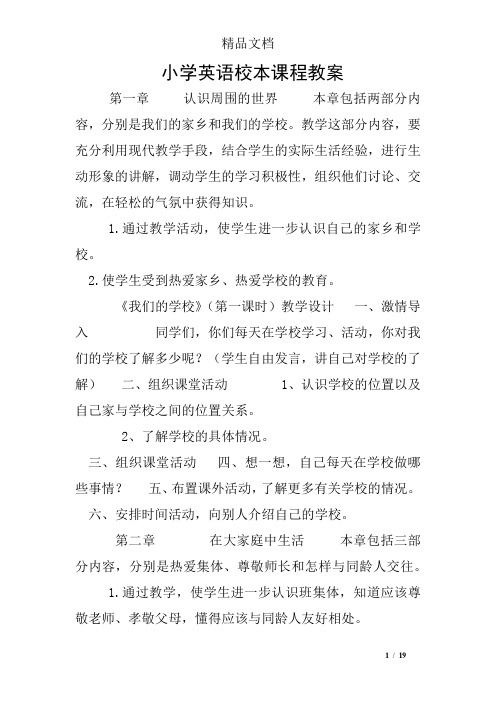
小学英语校本课程教案第一章认识周围的世界本章包括两部分内容,分别是我们的家乡和我们的学校。
教学这部分内容,要充分利用现代教学手段,结合学生的实际生活经验,进行生动形象的讲解,调动学生的学习积极性,组织他们讨论、交流,在轻松的气氛中获得知识。
1.通过教学活动,使学生进一步认识自己的家乡和学校。
2.使学生受到热爱家乡、热爱学校的教育。
《我们的学校》(第一课时)教学设计一、激情导入同学们,你们每天在学校学习、活动,你对我们的学校了解多少呢?(学生自由发言,讲自己对学校的了解)二、组织课堂活动 1、认识学校的位置以及自己家与学校之间的位置关系。
2、了解学校的具体情况。
三、组织课堂活动四、想一想,自己每天在学校做哪些事情?五、布置课外活动,了解更多有关学校的情况。
六、安排时间活动,向别人介绍自己的学校。
第二章在大家庭中生活本章包括三部分内容,分别是热爱集体、尊敬师长和怎样与同龄人交往。
1.通过教学,使学生进一步认识班集体,知道应该尊敬老师、孝敬父母,懂得应该与同龄人友好相处。
2.使学生受到集体主义教育,知道孝敬父母、尊敬老师是中华民族的传统美德,更热爱集体生活。
《热爱集体》教学过程一、谈话导入班集体是我们共同生活的大家庭,我们都要热爱这个集体。
二、看图讨论教师出示图片,学生看图讨论。
三、组织课堂活动你认为热爱集体表现在哪些方面?(学生讨论后教师可让几名学生发言)四、想一想 1.你做过那些有意集体的事情? 2.见到有损集体的现象应该怎么做?五、课堂小结第三章劳动创造了人类社会本章内容包括三部分,分别是劳动创造财富、劳动是中华民族的传统美德和在劳动中锻炼自己。
1.通过本章教学,使学生认识到劳动在历史发展中的作用,知道人的生活离不开劳动。
2.使学生认识到劳动是光荣的,受到热爱劳动的教育。
《劳动创造财富》(第一课时)教学设计一、谈话导入同学们,我们知道,人要生活,就必须劳动,因为劳动可以创造财富。
二、看图讨论教师出示图片,学生对图片进行讨论。
小学英语校本教材教案全册
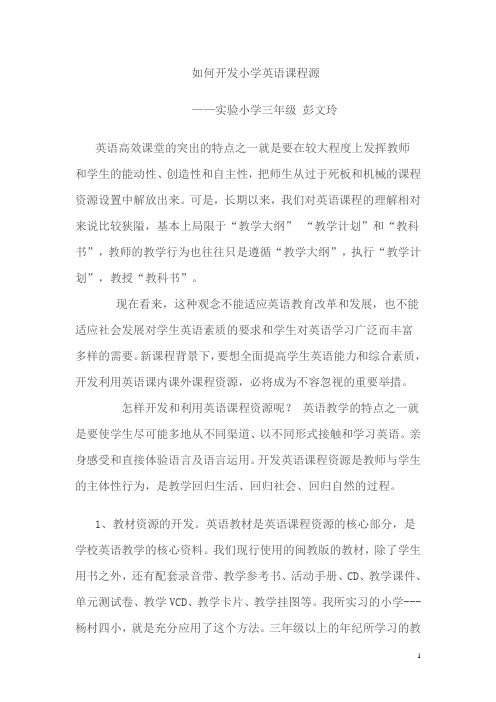
如何开发小学英语课程源——实验小学三年级彭文玲英语高效课堂的突出的特点之一就是要在较大程度上发挥教师和学生的能动性、创造性和自主性,把师生从过于死板和机械的课程资源设置中解放出来。
可是,长期以来,我们对英语课程的理解相对来说比较狭隘,基本上局限于“教学大纲” “教学计划”和“教科书”,教师的教学行为也往往只是遵循“教学大纲”,执行“教学计划”,教授“教科书”。
现在看来,这种观念不能适应英语教育改革和发展,也不能适应社会发展对学生英语素质的要求和学生对英语学习广泛而丰富多样的需要。
新课程背景下,要想全面提高学生英语能力和综合素质,开发利用英语课内课外课程资源,必将成为不容忽视的重要举措。
怎样开发和利用英语课程资源呢?英语教学的特点之一就是要使学生尽可能多地从不同渠道、以不同形式接触和学习英语。
亲身感受和直接体验语言及语言运用。
开发英语课程资源是教师与学生的主体性行为,是教学回归生活、回归社会、回归自然的过程。
1、教材资源的开发。
英语教材是英语课程资源的核心部分,是学校英语教学的核心资料。
我们现行使用的闽教版的教材,除了学生用书之外,还有配套录音带、教学参考书、活动手册、CD、教学课件、单元测试卷、教学VCD、教学卡片、教学挂图等。
我所实习的小学---杨村四小,就是充分应用了这个方法。
三年级以上的年纪所学习的教材是人民教育出版社出版的;而一、二年纪所学习的是《剑桥少儿英语》这套儿童英语教材里的内容,以此来补充和丰富课堂教学。
多种教材资源的开发和利用,体现了英语教学的开放性和灵活性,开阔了学生的视野。
还可以适当选用国外的教学资料,以补充和丰富课堂教学内容。
2、网络资源的开发。
网络资源浩如烟海,但真正与课本配套以及内容完全符合儿童特点的资源并不多。
因此,教师根据自己的教学需要,开发了一些英语网络资源。
比如可以建立“教案库”、“课件库”、“习题库”、“教学录像库”、“教学素材库”,专门存放教师的教案、课件、试卷、公开课、示范课、观摩课的录像、上网查找的资料等等。
小学英语校本课程教案
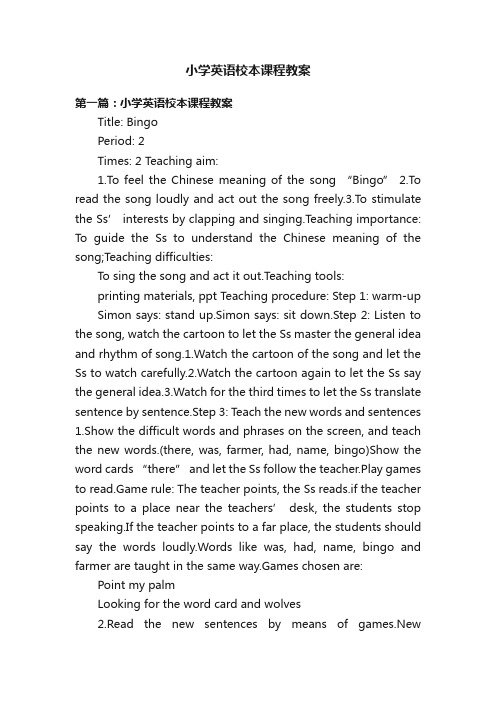
小学英语校本课程教案第一篇:小学英语校本课程教案Title: BingoPeriod: 2Times: 2 Teaching aim:1.To feel the Chinese meaning of the song “Bingo”2.To read the song loudly and act out the song freely.3.To stimulate the Ss’ interests by clapping and singing.T eaching importance: To guide the Ss to understand the Chinese meaning of the song;Teaching difficulties:To sing the song and act it out.Teaching tools:printing materials, ppt Teaching procedure: Step 1: warm-up Simon says: stand up.Simon says: sit down.Step 2: Listen to the song, watch the cartoon to let the Ss master the general idea and rhythm of song.1.Watch the cartoon of the song and let the Ss to watch carefully.2.Watch the cartoon again to let the Ss say the general idea.3.Watch for the third times to let the Ss translate sentence by sentence.Step 3: Teach the new words and sentences 1.Show the difficult words and phrases on the screen, and teach the new words.(there, was, farmer, had, name, bingo)Show the word cards “there” and let the Ss follow the teacher.Play games to read.Game rule: The teacher points, the Ss reads.if the teacher points to a place near the teachers’ desk, the students stop speaking.If the teacher points to a far place, the students should say the words loudly.Words like was, had, name, bingo and farmer are taught in the same way.Games chosen are: Point my palmLooking for the word card and wolves2.Read the new sentences by means of games.Newsentences: There was a farmer had a dog.Bingo was his name.Games: WhisperDriving cars Step 4: Learn to sing the songTeach the song sentence by sentence with the students followed.Let the Ss sing with the cartoon.Step 5: Practice Sing the song group by group to see which group is the best.Sing the song with the hands clapping.Sing the song with games.Game rule: Sit on the chairs, Ask seven students to go to the middle of the yard.The other sing the song.When the song stops, the Ss should sit on the six chairs as quickly as possible.The one who has no chairs should show us a play.Step 6: Activity Run run run, go go go;Jump jump jump, go go go;Shake shake shake, go go go.Cant and do.The Ss should run, jump and shake when they are chanting.Step7: Summary Sing the song again to end the class.Lyric:BingoThere was a farmer had a dog And Bingo was his name, Oh B-I-N-G-O, B-I-N-G-OB-I-N-G-OAnd Bingo was his name, Oh There was a farmer had a dog And Bingo was his name, OhI-N-G-O, I-N-G-O And Bingo was his name, Oh There was a farmer had a dog And Bingo was his name, OhN-G-O, N-G-O And Bingo was his name, Oh There was a farmer had a dog And Bingo was his name, OhG-O, G-OAnd Bingo was his name, Oh There was a farmer had a dog And Bingo was his name, OhO, OAnd Bingo was his name, Oh There was a farmer had a dog And Bingo was his name, Oh And Bingo was his name, Oh第二篇:英语校本课程教案英语校本课程教案校本课程教案-《哈姆雷特》鉴赏课教学目标:1、通过对莎士比亚作品《哈姆雷特》的赏析,初步培养学生主动了解并关注英语国家文化以及东西文化之间的差异;2、训练学生在观看英美原声影视作品的过程中所形成的听力技能;3、初步掌握一些英语语言中的俚语,加深对英语的理解;4、扩展学生知识面,拓宽学生国际视野,提升学生文化修养。
- 1、下载文档前请自行甄别文档内容的完整性,平台不提供额外的编辑、内容补充、找答案等附加服务。
- 2、"仅部分预览"的文档,不可在线预览部分如存在完整性等问题,可反馈申请退款(可完整预览的文档不适用该条件!)。
- 3、如文档侵犯您的权益,请联系客服反馈,我们会尽快为您处理(人工客服工作时间:9:00-18:30)。
小学英语校本教材教案全册如何开发小学英语课程源——实验小学三年级彭文玲英语高效课堂的突出的特点之一就是要在较大程度上发挥教师和学生的能动性、创造性和自主性,把师生从过于死板和机械的课程资源设置中解放出来。
可是,长期以来,我们对英语课程的理解相对来说比较狭隘,基本上局限于“教学大纲” “教学计划”和“教科书”,教师的教学行为也往往只是遵循“教学大纲”,执行“教学计划”,教授“教科书”。
现在看来,这种观念不能适应英语教育改革和发展,也不能适应社会发展对学生英语素质的要求和学生对英语学习广泛而丰富多样的需要。
新课程背景下,要想全面提高学生英语能力和综合素质,开发利用英语课内课外课程资源,必将成为不容忽视的重要举措。
怎样开发和利用英语课程资源呢, 英语教学的特点之一就是要使学生尽可能多地从不同渠道、以不同形式接触和学习英语。
亲身感受和直接体验语言及语言运用。
开发英语课程资源是教师与学生的主体性行为,是教学回归生活、回归社会、回归自然的过程。
1、教材资源的开发。
英语教材是英语课程资源的核心部分,是学校英语教学的核心资料。
我们现行使用的闽教版的教材,除了学生用书之外,还有配套录音带、教学参考书、活动手册、CD、教学课件、单元测试卷、教学VCD、教学卡片、教学挂图等。
我所实习的小学---杨村四小,就是充分应用了这个方法。
三年级以上的年纪所学习的教Million. Water quality standards the dredging of river boundary section obtained provincial environmental protection Office special bonuses for wetland construction ... ... Million. Butsober see, these achievements were made in the case of decreasedrainfall for two consecutive years, we realize that environmental protection work still faced many problems in our County. Mainly in the PM2.5 and PM10 air quality monitoring indicators often exceeding, dredging of river section's water quality is not stable, and rural non-point source pollution has not been radical, Wade through the corporate environmental risk, livestock pollution rebound from severe, a wealth of protection and use of water resources is not well. If this year's rainfall, these problems will be exposed, and raw materials caused a great deal of pressure to go green. To solve these problems, we focused on three aspects of the work of environmental protection: (a) in accordance with the ... ... Real good green. According to the "Garden City, roads, tree-lined, mountain forests of" principle, to develop "governance focused piece, scale" afforestation programmes, and actively implement the barren hills green, River afforestation increased, City Green, farmland and other greening works to ensure completeafforestation this year ... ... Acres and acres and afforestation in the plain ... ... Acres, new nursery wood ... ... MU.材是人民教育出版社出版的;而一、二年纪所学习的是《剑桥少儿英语》这套儿童英语教材里的内容,以此来补充和丰富课堂教学。
多种教材资源的开发和利用,体现了英语教学的开放性和灵活性,开阔了学生的视野。
还可以适当选用国外的教学资料,以补充和丰富课堂教学内容。
2、网络资源的开发。
网络资源浩如烟海,但真正与课本配套以及内容完全符合儿童特点的资源并不多。
因此,教师根据自己的教学需要,开发了一些英语网络资源。
比如可以建立“教案库”、“课件库”、“习题库”、“教学录像库”、“教学素材库”,专门存放教师的教案、课件、试卷、公开课、示范课、观摩课的录像、上网查找的资料等等。
3、学校资源的开发。
要充分利用学校的广播、图书馆、语音室和多媒体设备,全方位、多渠道的为学生提供英语学习的机会。
利用课外活动的时间,向学生播放一些经典的、有趣的、有教育意义的外国电影、歌曲、录像、教学片等,作为课堂教学的补充。
通过播放《你和我阶梯快乐儿童英语》、《音乐之声》、《狮子王》、《风中奇缘》等影片和英文儿歌,开展“海外剧场”、“歌曲欣赏”等活动,增加学生的真实语言输入。
还在校园的公共场所贴上英语名言、警句的标牌,在教学楼的长廊和墙壁上贴上图文并茂的英语故事,积累语言知识。
2, new nursery wood ... ... MU.Acres ther greening works to ensure complete afforestation this year ... ... Acres and acres and afforestation in the plain ... ...estation programmes, and actively implement the barren hills green, River afforestation increased, City Green, farmland and olined, mountain forests of" principle, to develop "governance focused piece, scale" affor-ccording to the "Garden City, roads, trees, we focused on three aspects of the work of environmental protection: (a) in accordance with the ... ... Real good green. Aroblemr's rainfall, these problems will be exposed, and raw materials caused a great deal of pressure to go green. To solve these ptal risk, livestock pollution rebound from severe, a wealth of protection and use of water resources is not well. If this yeapoint source pollution has not been radical, Wade through the corporate environmen-ion's water quality is not stable, and rural nonroblems in our County. Mainly in thePM2.5 and PM10 air quality monitoring indicators often exceeding, dredging of river sectany pmade in the case of decreased rainfall for two consecutive years, we realize that environmental protection work still faced m ironmental protection Office special bonuses for wetland construction ... ... Million. But sober see, these achievements wereMillion. Water quality standards the dredging of river boundary section obtained provincial env4、教室资源的开发。
在教室里,可以建立“英语角”、“英语图书角”。
“英语角”用来张贴学生制作的英文小报、单词图片、卡片等。
“英语角”增加了学生接触英语、识记英语的机会。
“英语图书角”则设在书柜里。
在书柜里专门辟出一层用来摆放儿童英语书和英语工具书。
英语书包括不同版本的小学英语教科书、英语图画书、英语童话书等。
5、社会资源的开发。
例如,广告、家用电器使用指南、药品说明书、路标、计算机程序等都有英语。
英语社会资源开发,就是要求学生注意收集、积累校外接触到的英语资源,如电视、杂志上的英语广告词、商品的英语说明书和英语格言等。
学生接触到这些英语可以利用“英语图书角”里的词典自查,也可以咨询老师。
学生对商品说明“MADE IN CHINA”、公共标志No smoking!以及计算机语言copy, window, edit等句子和词语耳熟能详,从而扩充了知识面6、教师资源的开发。
作为英语课程资源的开发和利用的主体——教师本身就是一个可以充分挖掘的课程资源。
教师的服饰、生日、家庭、爱好、身体语言、语音语调、人品学识、文化修养等都是宝贵的课程资源。
